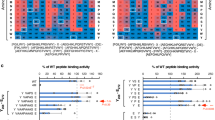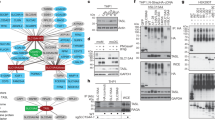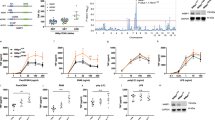Abstract
Toll-like receptor (TLR) signals that initiate innate immune responses to pathogens must be tightly regulated to prevent excessive inflammatory damage to the host. The adaptor protein Mal is specifically involved in signaling via TLR2 and TLR4. We demonstrate here that after TLR2 and TLR4 stimulation Mal becomes phosphorylated by Bruton's tyrosine kinase (Btk) and then interacts with SOCS-1, which results in Mal polyubiquitination and subsequent degradation. Removal of SOCS-1 regulation potentiates Mal-dependent p65 phosphorylation and transactivation of NF-κB, leading to amplified inflammatory responses. These data identify a target of SOCS-1 that regulates TLR signaling via a mechanism distinct from an autocrine cytokine response. The transient activation of Mal and subsequent SOCS-1–mediated degradation is a rapid and selective means of limiting primary innate immune response.
This is a preview of subscription content, access via your institution
Access options
Subscribe to this journal
Receive 12 print issues and online access
$209.00 per year
only $17.42 per issue
Buy this article
- Purchase on SpringerLink
- Instant access to full article PDF
Prices may be subject to local taxes which are calculated during checkout






Similar content being viewed by others
References
Takeda, K., Kaisho, T. & Akira, S. Toll-like receptors. Annu. Rev. Immunol. Vol. 21 (2003).
Dunne, A. & O'Neill, L.A. Adaptor usage and Toll-like receptor signaling specificity. FEBS Lett. 579, 3330–3335 (2005).
Akira, S. & Takeda, K. Toll-like receptor signalling. Nat. Rev. Immunol. 4, 499–511 (2004).
O'Neill, L.A., Fitzgerald, K.A. & Bowie, A.G. The Toll-IL-1 receptor adaptor family grows to five members. Trends Immunol. 24, 286–290 (2003).
Oshiumi, H. et al. TIR-containing adapter molecule (TICAM)-2, a bridging adapter recruiting to toll-like receptor 4 TICAM-1 that induces interferon-beta. J. Biol. Chem. 278, 49751–49762 (2003).
Fitzgerald, K.A. et al. LPS-TLR4 signaling to IRF-3/7 and NF-kappaB involves the toll adapters TRAM and TRIF. J. Exp. Med. 198, 1043–1055 (2003).
Horng, T., Barton, G.M., Flavell, R.A. & Medzhitov, R. The adaptor molecule TIRAP provides signalling specificity for Toll-like receptors. Nature 420, 329–333 (2002).
Yamamoto, M. et al. Essential role for TIRAP in activation of the signalling cascade shared by TLR2 and TLR4. Nature 420, 324–329 (2002).
Mansell, A., Brint, E., Gould, J.A., O'Neill, L.A. & Hertzog, P.J. Mal interacts with TNF receptor associated factor (TRAF)-6 to mediate NF-κB activation by Toll-like receptor (TLR)-2 and TLR4. J. Biol. Chem. 279, 37227–37230 (2004).
Liew, F.Y., Xu, D., Brint, E.K. & O'Neill, L.A. Negative regulation of toll-like receptor-mediated immune responses. Nat. Rev. Immunol. 5, 446–458 (2005).
Chuang, T.H. & Ulevitch, R.J. Triad3A, an E3 ubiquitin-protein ligase regulating Toll-like receptors. Nat. Immunol. 5, 495–502 (2004).
Wald, D. et al. SIGIRR, a negative regulator of Toll-like receptor-interleukin 1 receptor signaling. Nat. Immunol. 4, 920–927 (2003).
Janssens, S., Burns, K., Vercammen, E., Tschopp, J. & Beyaert, R. MyD88S, a splice variant of MyD88, differentially modulates NF-kappaB- and AP-1-dependent gene expression. FEBS Lett. 548, 103–107 (2003).
Naiki, Y. et al. Transforming growth factor-beta differentially inhibits MyD88-dependent, but not TRAM- and TRIF-dependent, lipopolysaccharide-induced TLR4 signaling. J. Biol. Chem. 280, 5491–5495 (2005).
Kobayashi, K. et al. IRAK-M is a negative regulator of Toll-like receptor signaling. Cell 110, 191–202 (2002).
Divanovic, S. et al. Negative regulation of Toll-like receptor 4 signaling by the Toll-like receptor homolog RP105. Nat. Immunol. 6, 571–578 (2005).
Naka, T. et al. Structure and function of a new STAT-induced STAT inhibitor. Nature 387, 924–929 (1997).
Endo, T.A. et al. A new protein containing an SH2 domain that inhibits JAK kinases. Nature 387, 921–924 (1997).
Starr, R. et al. A family of cytokine-inducible inhibitors of signalling. Nature 387, 917–921 (1997).
Alexander, W.S. & Hilton, D.J. The role of suppressors of cytokine signaling (SOCS) proteins in regulation of the immune response. Annu. Rev. Immunol. 22, 503–529 (2004).
Alexander, W.S. et al. SOCS1 is a critical inhibitor of interferon gamma signaling and prevents the potentially fatal neonatal actions of this cytokine. Cell 98, 597–608 (1999).
Baetz, A., Frey, M., Heeg, K. & Dalpke, A.H. Suppressor of cytokine signaling (SOCS) proteins indirectly regulate toll-like receptor signaling in innate immune cells. J. Biol. Chem. 279, 54708–54715 (2004).
Kinjyo, I. et al. SOCS1/JAB is a negative regulator of LPS-induced macrophage activation. Immunity 17, 583–591 (2002).
Nakagawa, R. et al. SOCS-1 participates in negative regulation of LPS responses. Immunity 17, 677–687 (2002).
Kamizono, S. et al. The SOCS box of SOCS-1 accelerates ubiquitin-dependent proteolysis of TEL-JAK2. J. Biol. Chem. 276, 12530–12538 (2001).
Zhang, J.G. et al. The conserved SOCS box motif in suppressors of cytokine signaling binds to elongins B and C and may couple bound proteins to proteasomal degradation. Proc. Natl. Acad. Sci. USA 96, 2071–2076 (1999).
Rechsteiner, M. & Rogers, S.W. PEST sequences and regulation by proteolysis. Trends Biochem. Sci. 21, 267–271 (1996).
Kile, B.T. et al. The SOCS box: a tale of destruction and degradation. Trends Biochem. Sci. 27, 235–241 (2002).
Nicholson, S.E. et al. Mutational analyses of the SOCS proteins suggest a dual domain requirement but distinct mechanisms for inhibition of LIF and IL-6 signal transduction. EMBO J. 18, 375–385 (1999).
Rawlings, D.J. et al. Mutation of unique region of Bruton's tyrosine kinase in immunodeficient XID mice. Science 261, 358–361 (1993).
Glickman, M.H. & Ciechanover, A. The ubiquitin-proteasome proteolytic pathway: destruction for the sake of construction. Physiol. Rev. 82, 373–428 (2002).
Fitzgerald, K.A. et al. Mal (MyD88-adapter-like) is required for Toll-like receptor-4 signal transduction. Nature 413, 78–83 (2001).
Vermeulen, L., De Wilde, G., Notebaert, S., Vanden Berghe, W. & Haegeman, G. Regulation of the transcriptional activity of the nuclear factor-kappaB p65 subunit. Biochem. Pharmacol. 64, 963–970 (2002).
Doyle, S.L., Jefferies, C.A. & O'Neill, L.A. Bruton's tyrosine kinase is involved in p65-mediated transactivation and phosphorylation of p65 on serine 536 during NFkappaB activation by lipopolysaccharide. J. Biol. Chem. 280, 23496–23501 (2005).
Gingras, S., Parganas, E., de Pauw, A., Ihle, J.N. & Murray, P.J. Re-examination of the role of suppressor of cytokine signaling 1 (SOCS1) in the regulation of toll-like receptor signaling. J. Biol. Chem. 279, 54702–54707 (2004).
Inagaki-Ohara, K., Hanada, T. & Yoshimura, A. Negative regulation of cytokine signaling and inflammatory diseases. Curr. Opin. Pharmacol. 3, 435–442 (2003).
Yoshimura, A., Ohishi, H.M., Aki, D. & Hanada, T. Regulation of TLR signaling and inflammation by SOCS family proteins. J. Leukoc. Biol. 75, 422–427 (2004).
Naka, T., Fujimoto, M. & Kishimoto, T. Negative regulation of cytokine signaling: STAT-induced STAT inhibitor. Trends Biochem. Sci. 24, 394–398 (1999).
Fenner, J.E. et al. Suppressor of cytokine signaling 1 regulates the immune response to infection by a unique inhibition of type I interferon activity. Nat. Immunol. 7, 33–39 (2005).
Noubir, S., Hmama, Z. & Reiner, N.E. Dual receptors and distinct pathways mediate interleukin-1 receptor-associated kinase degradation in response to lipopolysaccharide. Involvement of CD14/TLR4, CR3, and phosphatidylinositol 3-kinase. J. Biol. Chem. 279, 25189–25195 (2004).
Yamin, T.T. & Miller, D.K. The interleukin-1 receptor-associated kinase is degraded by proteasomes following its phosphorylation. J. Biol. Chem. 272, 21540–21547 (1997).
Sweet, M.J. et al. A novel pathway regulating lipopolysaccharide-induced shock by ST2/T1 via inhibition of Toll-like receptor 4 expression. J. Immunol. 166, 6633–6639 (2001).
Acknowledgements
We thank T. Lang, J. Kiu and K. Palmer for technical assistance. Supported by the National Health and Medical Research Council (334023 to A.M., 236866 to P.C. and 284220 to P.J.H.), Science Foundation Ireland and the Cooperative Research Centre for Oral Health Sciences (R.S.).
Author information
Authors and Affiliations
Corresponding author
Ethics declarations
Competing interests
The authors declare no competing financial interests.
Supplementary information
Supplementary Fig. 1
Schematic diagram illustrating the location within the N-terminal of the proline, glutamic acid, serine and threonine (PEST) rich domain located between residues human Mal (36-72) and murine Mal (43-76), proximal to their respective TIR domains; hMal (75-235), mMal (94-241). (PDF 125 kb)
Supplementary Fig. 2
Schematic diagram illustrating a role for Mal in mediating p65Ser536 phosphorylation of NF-κB, thereby inducing transcriptional activation of NF-κB, and its negative regulation by SOCS-1. (PDF 60 kb)
Rights and permissions
About this article
Cite this article
Mansell, A., Smith, R., Doyle, S. et al. Suppressor of cytokine signaling 1 negatively regulates Toll-like receptor signaling by mediating Mal degradation. Nat Immunol 7, 148–155 (2006). https://doi.org/10.1038/ni1299
Received:
Accepted:
Published:
Issue Date:
DOI: https://doi.org/10.1038/ni1299



